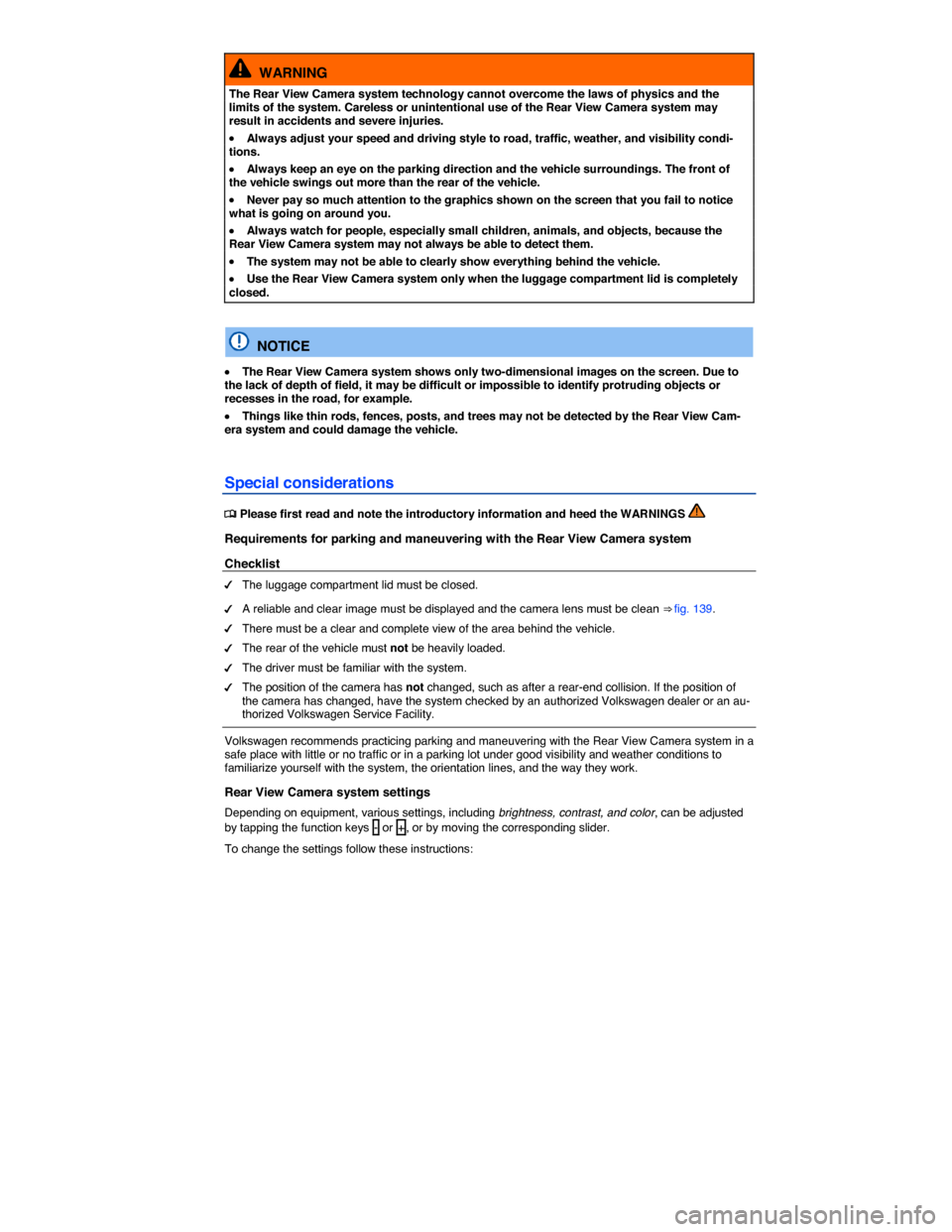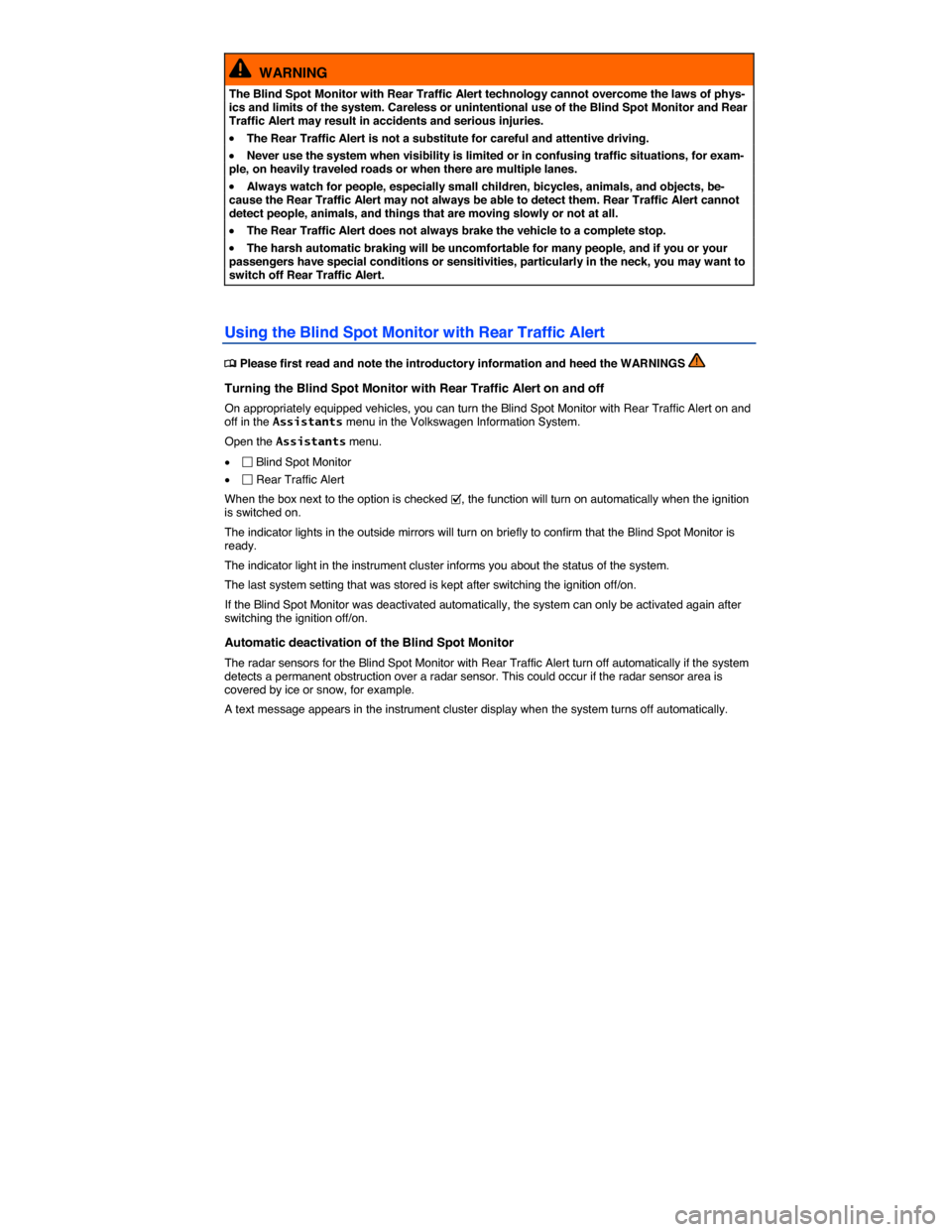Page 243 of 412

Changing brake fluid
Brake fluid must be changed according to the service schedule in your ⇒ Booklet Warranty and
Maintenance. Have the brake fluid checked by an authorized Volkswagen dealer or an authorized Volkswagen Service Facility. Refill only with new brake fluid that meets the standards listed above.
WARNING
Brake failure and reduced brake performance can be caused by not having enough brake fluid in the reservoir or by old or incorrect brake fluid.
�x Check the brake system and brake fluid level regularly.
�x Always change the brake fluid according to the service schedule in your
⇒ Booklet Warranty and Maintenance.
�x Hard braking with old brake fluid may cause vapor lock. Vapor lock reduces braking per-formance, increases stopping distances and can even cause total brake failure.
�x Always make sure that only the correct brake fluid is used. Only use brake fluid that ex-pressly conforms to VW Standard 501 14 or, if it is not available, only use a high-quality brake fluid that conforms to U.S. Standard FMVSS 116 DOT 4 requirements.
�x Using another brake fluid, or one that is not of high quality, can impair the function of the brake system and reduce its effectiveness. If the container does not say that the brake fluid complies with VW Standard 501 14, or U.S. Standard FMVSS 116 DOT 4, do not use it.
�x The brake fluid must be new.
WARNING
Brake fluid is poisonous.
�x To reduce the risk of poisoning, never use food, beverage or other non-original containers to store brake fluid. Someone might be misled by the original label on the container, or by the shape of the container, and drink the brake fluid. This could occur even if you relabel the container as “brake fluid.”
�x Only store brake fluid in the closed, original container and keep it out of the reach of chil-dren.
NOTICE
Brake fluid will damage vehicle paint, plastic parts, and tires. Wipe any brake fluid off vehicle paint and other vehicle parts immediately.
Brake fluid can pollute the environment. Brake fluid that has leaked out must be collected and disposed of properly, following all applicable environmental regulations.
Page 249 of 412

and release the parking brake while depressing the accelerator. For Hill Hold to work, the engine must be running and the vehicle must be in First Gear or Reverse (manual transmission) or in Drive (D), Sport Drive (S), or Reverse (R) (automatic transmission) and you must use the foot brake to hold the vehicle before starting to move.
Hill Hold keeps the brake applied for not quite 2 seconds with the same force you used to prevent the vehicle from moving. This gives you time to take your foot off the brake, let the clutch out on a manual transmission vehicle, and gently depress the accelerator to get the vehicle moving again. If you do not depress the accelerator pedal and get the vehicle moving again within this time, the brakes will release and the vehicle will roll downhill. Furthermore, if any requirement for engaging Hill Hold is no longer met while the vehicle is stopped, Hill Hold disengages and the brakes are automatically released and will no longer hold the vehicle.
Hill Hold is activated automatically when points 1 to 3 are met at the same time:
Step Manual transmission Automatic transmission
1. Hold the stopped vehicle on an incline with the foot or parking brake.
2. The engine must be running “smoothly.”
3.
A manual transmission vehicle must be in 1st gear (1) if headed up a hill or in Reverse (R) if backing up a hill; you must hold the clutch down and the foot brake must be depressed to keep the vehicle from moving.
An automatic transmission vehicle must be in Reverse (R), Drive (D), or Sport Drive (S) and the foot brake must be depressed to keep the vehicle from moving.
4.
To drive off, take your foot off the brake pedal as you let the clutch out and gently depress the accelerator within 2 seconds. If the accel-erator is not depressed, the brakes will re-lease automatically.
To drive off, take your foot off the brake pedal and gently depress the accelerator within 2 seconds.
Hill Hold is immediately deactivated:
�x If any requirement listed in the table above is no longer met.
�x If the engine is not running smoothly or the engine malfunctions.
�x If the engine stalls or is switched off.
�x If the driver door is opened.
�x Automatic transmission vehicles: If the transmission is in Neutral (N).
�x Automatic transmission vehicles: If a tire does not have enough road contact (such as when the vehicle is tipped or at an angle).
WARNING
The intelligent technology of Hill Hold cannot overcome the laws of physics. Never let the increased convenience provided by Hill Hold tempt you into taking risks.
�x The Hill Hold feature cannot hold the vehicle in all hill start situations (for example, if the surface is icy or slippery).
�x Hill Hold can only help keep the vehicle from moving for less than 2 seconds. After that, the brakes will be released and the vehicle can roll down the hill.
Page 251 of 412

Display
Different cruise control versions are available. The stored speed is shown in the instrument cluster display on some equipment versions.
Status fig. 137
(A) Cruise control temporarily deactivated. Stored speed displayed in small numbers.
(B) System malfunction. See an authorized Volkswagen dealer or an authorized Volkswagen Service Facility.
(C) Cruise control activated. No speed stored in memory.
(D) Cruise control is active. Stored speed displayed in large numbers.
Indicator lights
Lights up Possible cause
�% Cruise control is regulating the vehicle speed. �#�2�5�)�3�%
When the ignition is switched on, several warning and indicator lights come on briefly for a function check. They go out after a few seconds.
WARNING
Failure to heed warning lights and instrument cluster text messages can cause the vehicle to break down in traffic and result in a collision and serious personal injury.
�x Never ignore warning lights or text WARNINGS.
�x Always stop the vehicle as soon as it is safe to do so.
NOTICE
Failure to heed warning lights or text WARNINGS can result in vehicle damage.
Cruise control operation
Fig. 138 Left-hand side of the multi-function steering wheel: Buttons for operating the cruise control .
Page 255 of 412

WARNING
The Rear View Camera system technology cannot overcome the laws of physics and the limits of the system. Careless or unintentional use of the Rear View Camera system may result in accidents and severe injuries.
�x Always adjust your speed and driving style to road, traffic, weather, and visibility condi-tions.
�x Always keep an eye on the parking direction and the vehicle surroundings. The front of the vehicle swings out more than the rear of the vehicle.
�x Never pay so much attention to the graphics shown on the screen that you fail to notice what is going on around you.
�x Always watch for people, especially small children, animals, and objects, because the Rear View Camera system may not always be able to detect them.
�x The system may not be able to clearly show everything behind the vehicle.
�x Use the Rear View Camera system only when the luggage compartment lid is completely closed.
NOTICE
�x The Rear View Camera system shows only two-dimensional images on the screen. Due to the lack of depth of field, it may be difficult or impossible to identify protruding objects or recesses in the road, for example.
�x Things like thin rods, fences, posts, and trees may not be detected by the Rear View Cam-era system and could damage the vehicle.
Special considerations
�
Page 262 of 412
WARNING
Failure to heed warning and indicator lights and instrument cluster text messages can result in a collision and serious personal injury.
�x Never ignore warning and indicator lights or text WARNINGS.
�x Always heed warning and indicator lights and take action where necessary.
NOTICE
Failure to heed warning and indicator lights or text WARNINGS can result in vehicle damage.
Blind Spot Monitor
Fig. 142 In the outside mirrors: Indicator lights for the Blind Spot Monitor.
Fig. 143 Rear of the vehicle: Radar sensor areas.
�
Page 263 of 412

mirror A informs you about traffic to the left, and the indicator light in the passenger side outside mirror B informs you about traffic to the right of your vehicle.
Tinting on the side windows or aftermarket tinting films can interfere with the indicator lights in the outside mirrors or cause false readings.
Keep the glass in the outside mirrors clean and free of snow and ice, and do not cover the mirrors with stickers or other objects.
Radar sensors
The radar sensors are behind the rear bumper on the left and right ⇒ fig. 143. They are not visible from outside the vehicle. They monitor an area about 21 yards (20 meters) behind the vehicle as well as the blind spots on the left and right sides of the vehicle. The monitored area next to the vehicle is about one lane wide.
The width of the lane is not detected individually on each road, but is preprogrammed into the system. Because of this, the indicators may be incorrect when driving on narrow roads or driving in the center of two lanes. Likewise, vehicles that are two lanes away from you or stationary objects such as guard rails may also be detected and cause a false warning.
Driving situations
Fig. 144 A: Driving situation when passing with traffic behind your vehicle. B: Blind Spot Monitor indicator light in the driver side mirror.
Fig. 145 A: Driving situation when passing and merging into the lane. B: Blind Spot Monitor indicator light in the passenger side mirror.
�
Page 265 of 412

WARNING
The Blind Spot Monitor with Rear Traffic Alert technology cannot overcome the laws of phys-ics and limits of the system. Careless or unintentional use of the Blind Spot Monitor and Rear Traffic Alert may result in accidents and serious injuries.
�x The Rear Traffic Alert is not a substitute for careful and attentive driving.
�x Never use the system when visibility is limited or in confusing traffic situations, for exam-ple, on heavily traveled roads or when there are multiple lanes.
�x Always watch for people, especially small children, bicycles, animals, and objects, be-cause the Rear Traffic Alert may not always be able to detect them. Rear Traffic Alert cannot detect people, animals, and things that are moving slowly or not at all.
�x The Rear Traffic Alert does not always brake the vehicle to a complete stop.
�x The harsh automatic braking will be uncomfortable for many people, and if you or your passengers have special conditions or sensitivities, particularly in the neck, you may want to switch off Rear Traffic Alert.
Using the Blind Spot Monitor with Rear Traffic Alert
�
Page 266 of 412
Forward Collision Warning (Front Assist)
�